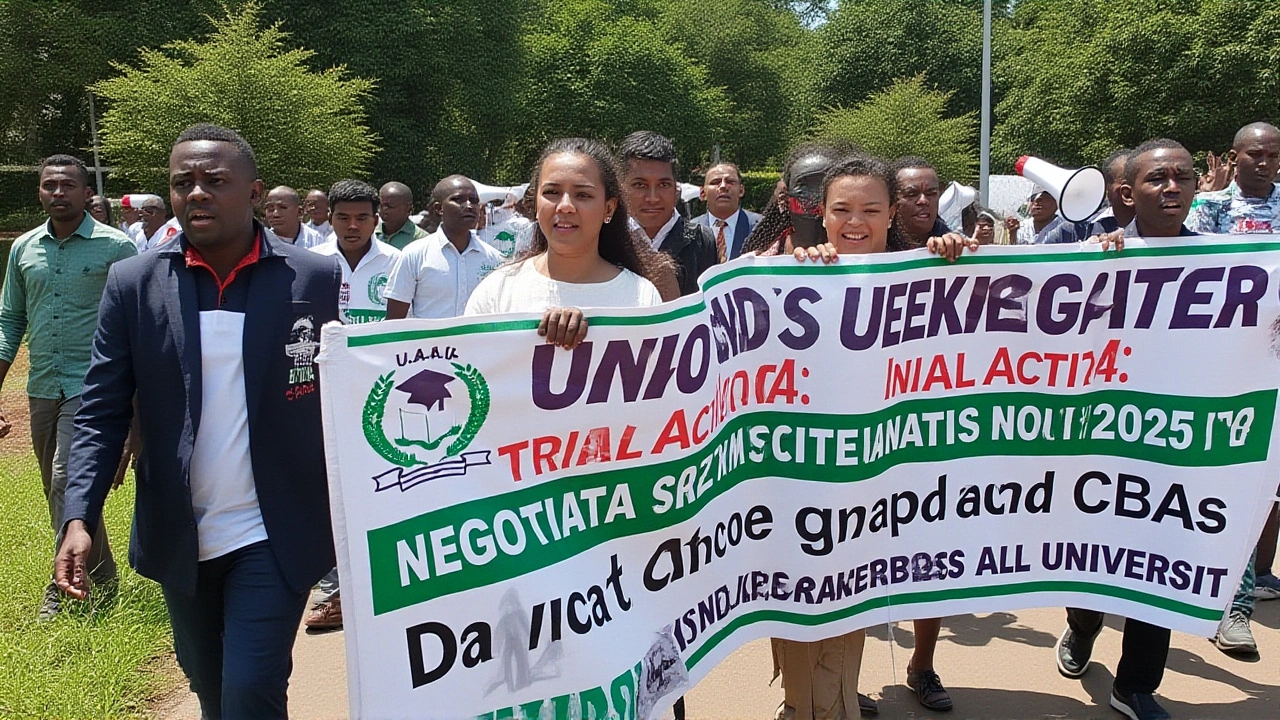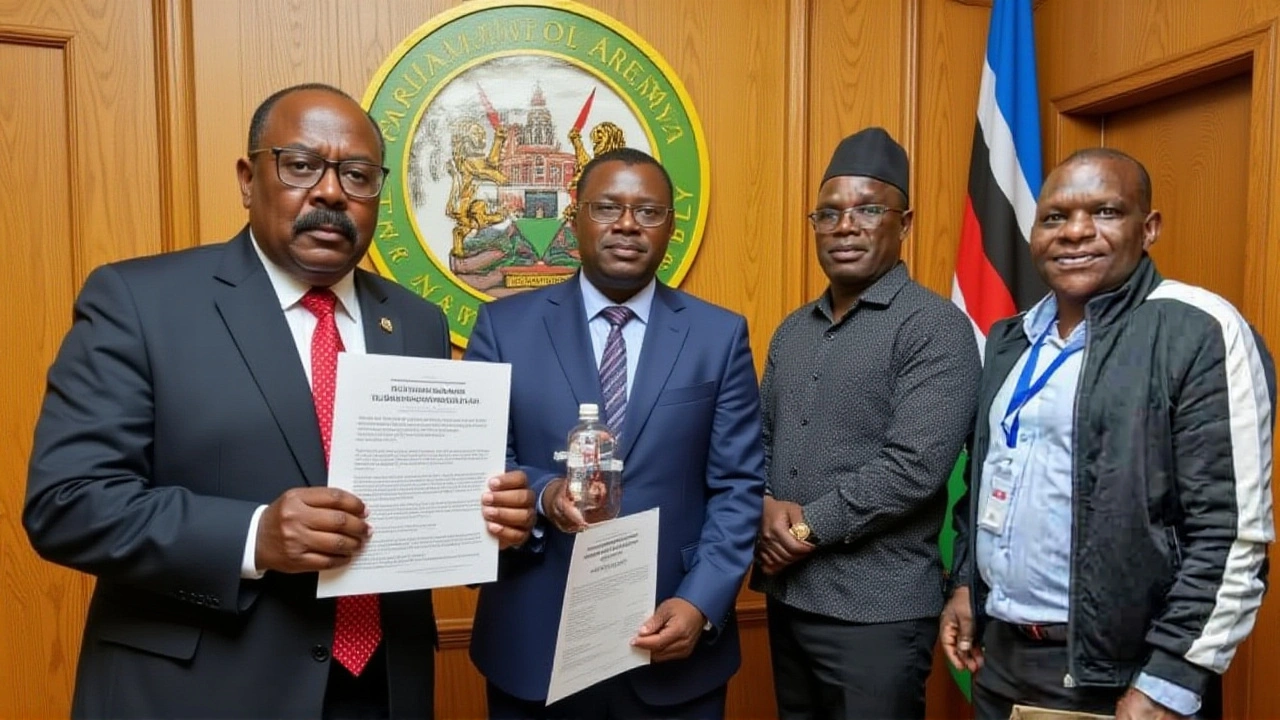When Moses Wetang'ula, Speaker of the National Assembly of Parliament of Kenya stepped onto the floor of the Parliament Buildings on Tuesday, September 24, 2025, he faced a nation on edge. The university strike that had frozen classrooms, labs and exam halls across all 39 public universities was now a political flashpoint, and the Speaker’s plea for dialogue carried the weight of both legislative authority and public frustration.
Background: The 2021 Court Order and Past CBAs
To understand why the staff walked out, you have to go back to a 2021 High Court ruling that ordered the government to fully fund the 2017‑21 Collective Bargaining Agreement (CBA). That agreement, signed after months of negotiations, promised salary increments and allowances that were never fully paid. The court’s injunction was clear: the Ministry of Education, the National Treasury and the Inter‑Public Universities Councils Consultative Forum (IPUCCF) had to honor the commitment.
Instead, successive budgets left a staggering shortfall. By 2025, the arrears had ballooned to Sh11.53 billion – a figure that includes Sh2.73 billion from the unfinished second phase of the 2021‑25 CBA and a lingering Sh8.8 billion from the earlier 2017‑21 deal. The money, roughly equivalent to $96 million, sat on the government’s books while lecturers, lab technicians and administrative staff saw their paychecks shrink.
Strike Timeline and Immediate Impact
The spark ignited on September 17, 2025, when the Universities Academic Staff Union (UASU) and the Kenya Universities Staff Union (KUSU) announced a nationwide strike. Their demands were simple on paper but massive in scale: immediate payment of the full Sh11.53 billion owed and the swift negotiation of a new 2025‑29 CBA.Within hours, lectures were cancelled at the University of Nairobi, Moi University, Egerton University and every other public institution. Final‑year students, many of whom were gearing up for end‑of‑semester examinations, found themselves staring at blank timetables. Research projects delayed, grant applications stalled, and overseas partners expressed concern over the disruption to collaborative work.
By the weekend, the Ministry of Education confirmed that all 39 universities had reported a 100 % suspension of teaching and assessment activities. The Kenya National Bureau of Statistics estimated that over 250,000 students were directly affected, while the economic cost of delayed graduations could run into the tens of millions of shillings in lost earnings.
Speaker Wetang'ula’s Intervention
On the morning of September 24, Wetang'ula met separately with senior officials from UASU and KUSU inside the historic chambers of Parliament Buildings. "I understand your grievances," the Speaker said, acknowledging the unions’ claim that the government had breached both the 2021 court order and the spirit of the earlier CBAs. "But the cost of this strike is being shouldered by the very students you were hired to educate."
He urged both unions to suspend the industrial action immediately and return to the negotiation table. "Parliament stands ready to mediate," Wetang'ula added, "and we will ensure any agreement is legally binding and financially feasible for the Treasury."
The Speaker’s remarks were met with a cautious nod from union representatives. They agreed to a 48‑hour cooling‑off period to assess the proposal, a move that temporarily halted the strike's most disruptive phase.
Reactions from Unions and Government Bodies
UASU secretary‑general Prof. John Mwangi called the meeting "a constructive step," but warned that any solution must include "full payment of the pending Sh11.53 billion and a clear timeline for the new CBA."
KUSU president Aisha Hassan echoed the sentiment, adding that the unions would monitor the government's compliance closely. "A temporary pause is not enough; we need guarantees," she said.
The Ministry of Education, represented by Cabinet Secretary George Magoha, announced that a special task force would be set up to review the arrears and propose a financing plan. The National Treasury, through Principal Secretary Faith Karanja, confirmed that a budget amendment could be tabled in the upcoming parliamentary session.
Meanwhile, the IPUCCF issued a statement emphasizing the need for "transparent accounting and a joint monitoring committee" to avoid future disputes.
Potential Paths Forward and What’s at Stake
Experts say the strike could either end with a quick settlement or morph into a protracted standoff. Dr. Samuel Ochieng, a labor economist at the University of Nairobi, warns that "if the government defaults again, we could see a cascade of strikes across secondary education and health sectors, given the precedent set here."
On the other hand, political analysts note that the Speaker’s willingness to mediate could set a new norm for parliamentary involvement in labor disputes, potentially strengthening the legislature’s role as an arbitrator.
- Key figure: Speaker Moses Wetang'ula – calls for dialogue.
- Unions: UASU and KUSU – demand Sh11.53 billion.
- Government bodies: Ministry of Education, National Treasury, IPUCCF.
- Impact: 39 public universities, ~250,000 students, delayed research.
- Timeline: Strike began 17 Sept 2025; pause agreed 24 Sept 2025.
What happens next will depend on whether a financing package can be approved before the next academic semester. If a deal is struck, lectures could resume within two weeks, giving students a chance to sit their finals. If not, the academic calendar could slip by months, forcing the Ministry to consider a shortened term or even a shift to a summer‑session model.

Frequently Asked Questions
How does the strike affect current university students?
With lectures, exams and research halted at all 39 public universities, roughly 250,000 students have faced delayed graduation timelines. Those in final semesters risk missing the usual September‑October exam window, potentially pushing their entry into the job market back by a year.
What are the unions specifically demanding in monetary terms?
The unions have quoted a total arrears figure of Sh11.53 billion. That breaks down into Sh2.73 billion owed from the second phase of the 2021‑25 CBA and Sh8.8 billion carried over from the 2017‑21 agreement, which the 2021 court order said the government must pay.
Why is the Speaker of the National Assembly involved?
Speaker Wetang'ula invoked Parliament’s constitutional role to mediate national disputes. By offering the House as a neutral venue, he hopes to broker a legally binding agreement that satisfies both the unions’ repayment claims and the Treasury’s budget constraints.
What could happen if the strike continues beyond the next month?
Extended disruption would likely force the Ministry of Education to restructure the academic calendar, possibly instituting a compressed term or shifting to a summer session. Prolonged unrest may also trigger similar actions in other public sectors, straining the national economy.
What legal precedent does the 2021 court order set?
The 2021 ruling affirmed that the government is legally bound to fully honour negotiated CBAs. Failure to comply not only breaches contract law but also opens the door for contempt proceedings, giving unions a strong leverage point in negotiations.

Trupti Jain
October 1, 2025 AT 22:13The Kenyan university strike is a textbook case of promises turned to dust.
When the courts mandated the full funding of the 2017‑21 CBA, the government apparently hit the snooze button.
Decades of fiscal gymnastics have left a gargantuan Sh11.53 billion hanging in limbo.
Lecturers, who once dreamed of modest raises, now stare at empty pay packets.
The Ministry of Education, instead of stepping up, seems to be playing musical chairs with budgets.
Meanwhile, students are caught in the crossfire, their lectures turned into silent echo chambers.
The Speaker’s intervention, though symbolic, is akin to a fire‑fighter tossing a wet towel on a blazing inferno.
Dialogue is laudable, but without hard cash the strike will simply echo louder.
The IPUCCF’s role feels more like a perfunctory nod than a real mediator.
Political flashpoints rarely resolve themselves with polite speeches.
Kenya’s reputation as a hub for higher education hangs in the balance.
The public deserves transparency on how that Sh11.53 billion will be allocated.
If the treasury continues to hoard the funds, the strike may stretch into the next academic year.
Stakeholders should draft a pragmatic roadmap, with milestones and penalties for missed payments.
Only then can the nation hope to restore its classrooms from a state of inertia.
deepika balodi
October 1, 2025 AT 22:46The strike highlights a glaring policy failure, and the workers deserve immediate redress.
Himanshu Sanduja
October 1, 2025 AT 23:20hey guys this whole mess feels like a bad sequel its not funny and we need real action
Kiran Singh
October 1, 2025 AT 23:53finally some progress 🎉 hoping the talks turn into cash flow soon 🤞
Balaji Srinivasan
October 2, 2025 AT 00:26the unions are right to stand firm, the budget should reflect their demands
Hariprasath P
October 2, 2025 AT 01:00i cant even begin to grasp how such a massive sum just disappeard into teh void its totally unrealistic and definetly a sign of mismanagement
Vibhor Jain
October 2, 2025 AT 01:33oh wonderful, another round of speeches that lead nowhere, classic.
Shubham Abhang
October 2, 2025 AT 02:06Wow, what a development, the Speaker finally steps onto the floor, and suddenly everyone expects miracles, but where's the money, where's the plan, where's the accountability?
Priya Patil
October 2, 2025 AT 02:40The strike is a symptom, not the disease. If the government fixes the budget, peace will follow. Otherwise, we're back to square one.
Rashi Jaiswal
October 2, 2025 AT 03:13lets keep the vibe positive, we can push this through together, I belive in a win for all